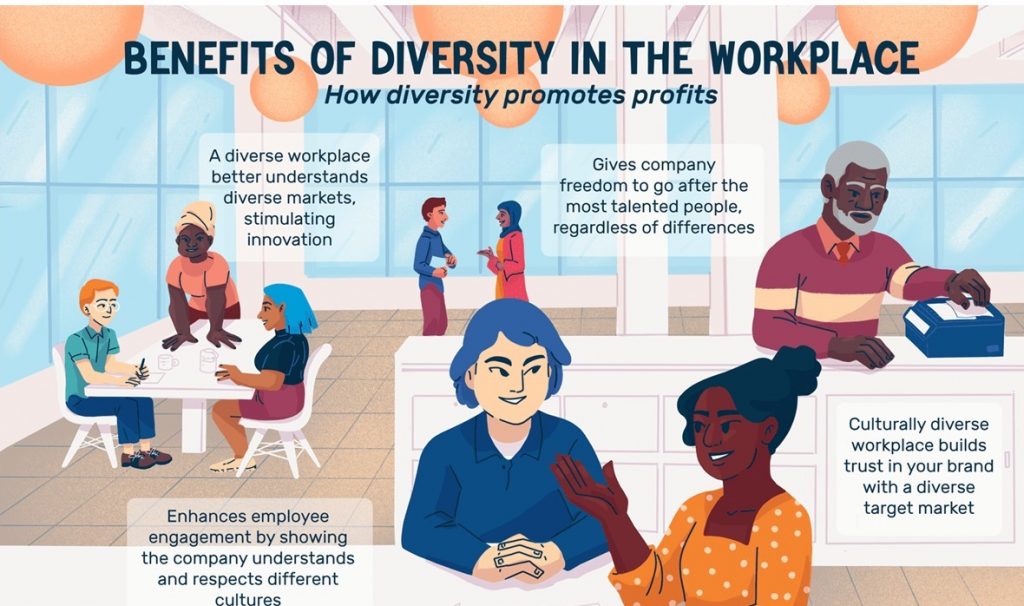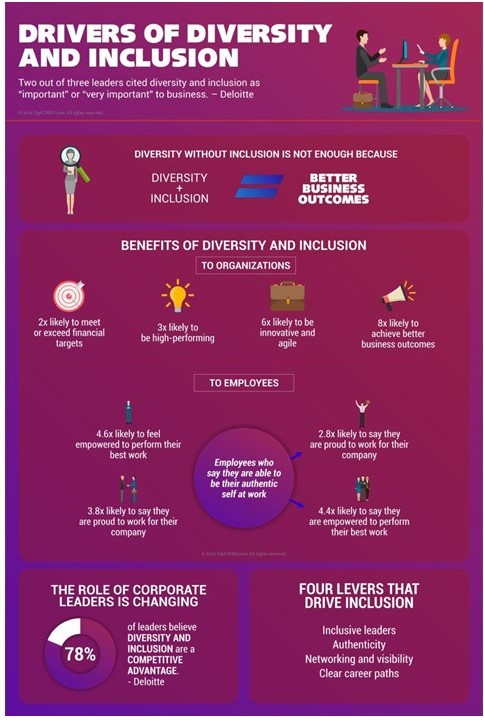Intercultural Communication
Learning Objectives
 After reviewing this information, you will be able to
After reviewing this information, you will be able to
-
-
- define intercultural communication in the context of professional interactions.
- identify several benefits of intercultural communication
- identify the five dimensions of cultural
- explain strategies for how to establish and maintain friendly professional relations with people from different cultures
-
Introduction
All communication is intercultural. The term “intercultural communication” might bring to mind people from different continents interacting, but within the United States, intercultural communication happens every day due to the country’s vast diversity. Much of our communication is inherently intercultural from coast to coast, urban centers to rural communities, Indigenous peoples to first-generation immigrants, and various regional cultures. You can hear it in the distinct accents, see it in multiple traditions, and feel it in the differing values across states, cities, and neighborhoods. Every culture you’ve been part of has shaped your worldview and behavior in some way, yet despite these differences, we manage to come together as a nation, highlighting our ability to navigate these diverse perspectives.
Always approach intercultural communication as an opportunity to bridge cultural gaps and build mutual understanding. To thrive in the United States’ multicultural environment, you must move beyond media-driven stereotypes and simplistic assumptions. Intercultural communication requires openness, patience, and a willingness to learn from others.
If your work involves interacting with people from cultures you’re unfamiliar with, set aside preconceived notions and take the time to learn about them by both researching and engaging in respectful dialogue. This chapter offers key principles for effective intercultural communication in the workplace, focusing on finding common ground, recognizing cultural differences, and adapting appropriately in each situation.
Common Cultural Characteristics
Culture involves beliefs, attitudes, values, and traditions that are shared by a group of people. Thus, we must consider more than the clothes we wear, the movies we watch, or the video games we play as the only representation of a culture. Culture also involves the psychological aspects of our expectations of the communication context. For example, if we are raised in a culture where males speak while females are expected to remain silent, the context of the communication interaction governs behavior, which in itself is a representation of culture. From the choice of words (message), to how we communicate (in person, or by e-mail), to how we acknowledge understanding with a nod or a glance (nonverbal feedback), to the internal and external interference, all aspects of communication are influenced by culture.
Culture is part of the very fabric of our thought, and we cannot separate ourselves from it, even as we leave home, defining ourselves anew in work and achievements. Every business or organization has a culture, and within what may be considered a global culture, there are many co-cultures. For example, consider the difference between the sales and accounting departments in a corporation. We can quickly see two distinct groups with their own symbols, vocabulary, and values. Within each group, there may also be smaller groups, and each member of each department comes from a distinct background that in itself influences behavior and interaction.
Ethnocentrism is the tendency to view other cultures as inferior to one’s own. Having pride in your culture can be healthy, but history has taught us that having a predisposition to discount other cultures simply because they are different can be hurtful, damaging, and dangerous. Ethnocentrism makes us far less likely to be able to bridge the gap with others and often increases intolerance of difference. Business and industry are no longer regional, and in your career, you will necessarily cross borders, languages, and cultures. You will need tolerance, understanding, patience, and openness to difference. A skilled business communicator knows that the process of learning is never complete, and being open to new ideas is a key strategy for success.

5 Dimensions of Culture
Successfully communicating across cultures requires understanding and respecting how the culture or cultures you represent differ from those of the people you’re communicating with. While you may think that you should just follow the golden rule and treat everyone else the way you would like to be treated yourself, the more you travel to distant lands, the more you realize that cultural conventions and expectations for how people would like to be treated are relative. One culture will place a high value on a friendly handshake and eye contact, while you would come off as aggressive or awkward if you did those things well in another.
Though you can’t be expected to know every little custom across the planet, having a general sense of large-scale cultural differences and a willingness to learn the details as necessary can save you from embarrassing yourself or offending people of different cultures when interacting with them. An open approach to cultural differences can also impress your audiences in ways favorable to your reputation and the organization you represent. With this goal in mind, let’s examine five broad categories of culture.
Context
Cultures can be divided into two distinct context categories: low and high context cultures. Low context cultures are said to logical, analytical and action oriented. A direct and straightforward communication style tends to be the communication pattern. Countries in North America and many European countries are considered low-context in orientation. High context cultures on the other hand are more intuitive in their communication style. Non-verbal communication: voice tone, eye contact, gestures, and posture, plays a more important part in communication. Speakers use indirect communication to communicate messages. Asian, African, and many Latin American cultures are considered high-context cultures.
Individualism
Individualism refers to a culture’s attitude towards independence and control. People in low context cultures tend to be very individualistic, that is, they value independence, freedom, initiative, personal responsibility and resist many forms of control. Competition and personal achievement is hardwired into the culture as people try to stand out from one another. On the other hand, people in high context cultures tend to be group oriented. Acceptance of group values, duties, and responsibilities is encouraged. High context cultures resist independence, freedom, and competition. People would rather blend than stand out.
Formality
Formality is the degree to which a culture places emphasis on tradition, ceremony, and social rules. In low context cultures, tradition is not an important value. This lack of value is exhibited in a more casual business attire, use of informal language to address superiors and the elderly, and lack of rituals. In low context cultures, social mobility is more possible and likely to occur. On the other hand, high context cultures value tradition. This value is exhibited is the wearing of formal business attire, the use of formal greetings with superiors and the elderly, and observance of rituals. In high context cultures, social mobility is often very difficult and unlikely to occur.
Communication Style
Communication style refers to the value place on verbal or non-verbal communication. Low context cultures place a high degree of importance on verbal communication. Low context cultures take words literally and value straightforward communication, words are suppose to mean what they say. On the other hand, high context cultures place more importance on the surrounding context than on the actual words. Words are only part of the message, and a lesser part of the message than all the other information connected to the message.
Time Orientation
Time orientation refers to the degree to which a culture considers time limited. In low context cultures, time is limited and considered a commodity. Time is connected to productivity, efficiency, and money. The saying “time is money” is part of commonplace. Waiting is wasting time and considered rude. On the other hand, time is unlimited in high context cultures. Time is a resource to be enjoyed. Decisions take time, meetings do not always start on time, and it is not considered rude to keep someone waiting.
Business Etiquette
Business etiquette involves fostering positive relationships with others and establishing a sense of comfort and security through effective communication. It is less about strict rules and more about creating an environment where everyone feels at ease. While the fundamentals of business etiquette can differ across cultures, mastering them can be crucial in achieving success in business interactions, as it can be the deciding factor between success and failure.
In many parts of the world, business is conducted more formally than in the U.S. As a result, it’s essential to avoid being overly informal, particularly in initial meetings. Building relationships is a key element of business success in many cultures. Nelson (2009) provides some general guidelines for international business interactions:
- Accurately remembering and pronouncing people’s names.
- Using proper titles and acknowledging rank where necessary.
- Being aware of local expectations regarding time and punctuality.
- Dressing appropriately to create a positive impression.
- Demonstrating concern for others through tact, discretion, and understanding of local etiquette and ethical standards.
- Practicing intercultural communication with sensitivity, whether verbally, nonverbally, or in writing, whether in person or electronically.
- Giving and receiving gifts and favors in alignment with local traditions.
- Participating in social events with awareness of cultural customs around food, drink, and dining practices, including utensil use, dining out, entertaining, and seating arrangements.
Conclusion

References
Guffey, M., Loewry, D., & Griffin, E. (2019). Business communication: Process and product (6th ed.). Toronto, ON: Nelson Education. Retrieved from http://www.cengage.com/cgi-wadsworth/course_products_wp.pl?fid=M20b&product_isbn_issn=9780176531393&template=NELSON
Institute of Cultural Diversity. (2019). Why is culture so important in the workplace. Retrieved from https://instituteofculturalintelligence.com/2019/07/23/why-is-cultural-diversity-important-in-the-workplace/
Nelson, C. R. (2009). The recipe for business success: balancing the required ingredients and execution.
Skills Boosters. (2014). Cultural awareness in the workplace [Video]. Youtube. https://www.youtube.com/watch?v=4Gwgls50J30
The Balance. (2020). Cultural diversity in the workplace. Retrieved from https://www.thebalance.com/cultural-diversity-3306201
Communication between or among people who have different cultural traditions.
The way a culture perceives the world around them which influences its interaction with others
The way we understand reality, largely based on experience
Learned habit to respond to something
Long lasting concept of what is right and wrong.
Basic foundation that guides or motivates beliefs and actions.
The passing of customs and beliefs from one generation to another.
A culture that exists within a larger cultural context (e.g. Jews, Christians, Muslims, etc.)

